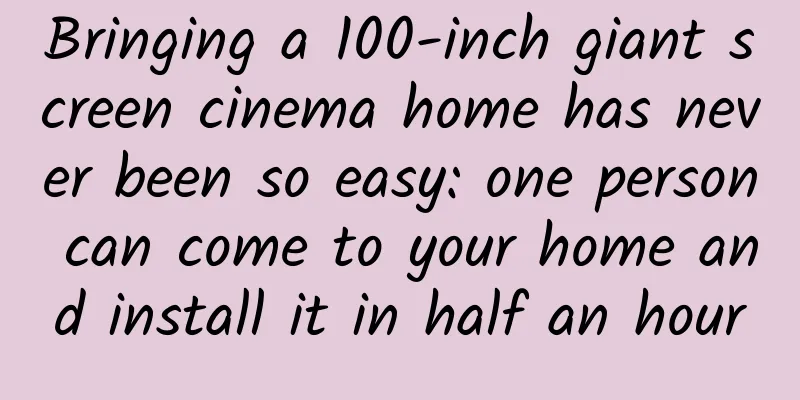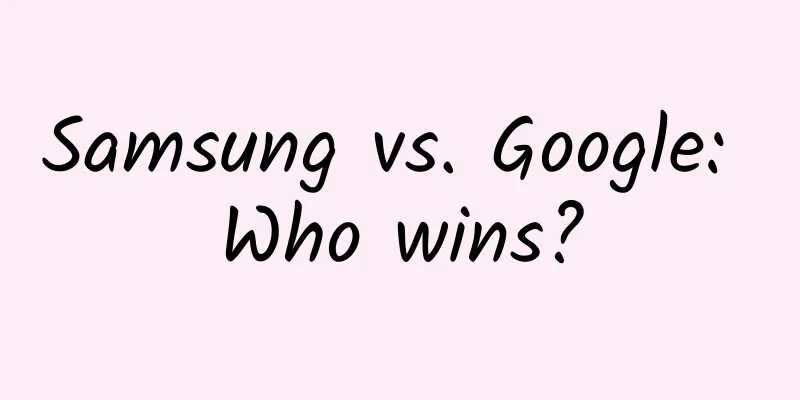Bringing a 100-inch giant screen cinema home has never been so easy: one person can come to your home and install it in half an hour

|
In the long history of the development of the television industry, LCD technology and laser technology are moving along different trajectories. The two complement each other and jointly promote changes in the home audio-visual experience. LCD technology, with its long-term accumulated advantages, occupies an important position in the small and medium-sized fields. With the iteration of technology, the yield of large-size panels has increased and the cost has decreased, making the price of 100-inch TVs gradually affordable. Mini LED technology has also enabled LCD TVs to make significant progress in brightness and contrast. However, at the same time, laser TV has quietly risen with its unique charm, targeting the market segment of larger size and ultimate cinema viewing experience. Combined with the growing audio-visual needs of current consumers, it is firmly believed that laser TV is ushering in a wave of development opportunities. The Dilemma of Large Screens and the Breakthrough of Laser This view comes from insights into three major trends in the television industry: larger screens, higher definition, and healthier televisions. Large screen is easy to understand. Today, the color TV market has entered the stock stage, but consumers' demand for large screen TV is growing. Structural upgrades oriented towards large screen have become the main driving force of the market. The improvement of immersion brought by large screen is the most immediate, and the large screen trend in the TV industry is also the most obvious trend in the industry. The average size of TVs sold in the Chinese market in recent years is as follows: 52.4 inches in 2020, 53.1 inches in 2021, 57.4 inches in 2022, and over 60 inches in 2023. At the beginning of 2024, the average size of the offline TV market was 67 inches. During the just-concluded "Double Eleven" period, the best-selling TV size was 75 inches, with a retail volume share of 30.5%, and sales of TVs above 75 inches accounted for more than half. The reason is not difficult to understand. Nowadays, smartphones are so popular and developed that the viewing experience of small-size TVs is not as good as the small screens that everyone carries with them, so consumers’ motivation to buy them is naturally much smaller. But it should be noted that once the size of an LCD TV exceeds 85 inches, home installation becomes a big problem. Generally, an 85-inch TV has a 16:9 ratio, is about 191.6 cm long and 110.1 cm wide, which is nearly 30% larger than a 75-inch TV. The size of some residential elevators and doors may not be able to accommodate it when laid flat. For example, the diagonal length of the elevator cabin in some old communities or small-sized residences may be smaller than the length of an 85-inch TV, making it impossible to transport it normally through the elevator. The only option is to lift it into the house from a window or other location, which will increase the complexity and cost of installation and also pose certain safety risks. An 85-inch LCD TV generally weighs around 50kg, which is much heavier than small and medium-sized TVs. This places higher demands on the installer's physical strength and installation tools, and can easily cause personal injury or damage to the TV during transportation. When hanging, the wall needs to have sufficient load-bearing capacity to support the weight of the TV. If it is an ordinary non-load-bearing wall, it may not be able to bear the long-term weight of the TV, which may pose a safety hazard. The wall needs to be reinforced, such as adding a backboard, using special expansion bolts, etc., which undoubtedly increases the difficulty and cost of installation. When installed on a stand, due to the large size and high center of gravity of the TV, its base needs to occupy a larger space, and it is necessary to ensure that there is sufficient friction and stability between the base and the TV cabinet or placement surface to prevent the TV from tipping over due to external force collision or other reasons. There are countless examples of similar cases of TVs falling and being damaged during transportation, installation, and post-installation use. A simple search on the Internet will reveal a lot of them. The larger the size of the LCD TV, the higher the risk of home installation, and the greater the loss if a problem occurs. Since the laser TV body and the anti-glare screen are separated, the difficulty of transportation and installation is much smaller. Hisense, a leading laser TV company, has also developed folding screen technology. After folding, the volume of a 100-inch laser TV screen is only equivalent to that of an adult, and the floor space is equivalent to that of an iPad. It weighs only a dozen kilograms and can be easily carried and installed by one person in about half an hour. The trend of high-definition television is also not difficult to understand. Although the display effect of smartphone screens is changing with each passing day, it is still not as immersive as large screens. Just as television has been invented for nearly a hundred years, it has never really replaced the sense of presence in movie theaters. For the same reason, although many people believe that LCD TVs are ahead of laser TVs in terms of brightness and resistance to environmental interference, in fact, laser TVs themselves are also constantly developing and innovating, becoming more and more trendy. In terms of technological innovation, laser TV has achieved 4K. Currently, all laser TVs priced above 10,000 yuan have 4K resolution, which brings consumers clearer and more realistic picture effects. At the same time, the light source of laser TV has also developed from monochrome laser to dual-color laser and three-color laser, with a higher and higher color gamut, and the color performance is not inferior to LCD TV. Moreover, the DLP laser projection technology used by laser TVs has won the Academy Award for Science and Technology and is the same technology used in 90% of cinemas around the world. Therefore, laser is currently the only display technology that can fully cover all film source colors, whether it is the current mainstream DCI-P3 or the future BT.2020. Even the image restoration center of Xiying Film Studio (Red Sorghum, Farewell My Concubine, etc.) uses laser TVs from Hisense for film review. Therefore, for those who love large-screen TVs and dream of having a giant-screen theater at home, choosing laser TV is a safer choice. Because of the homology of multiple dimensions such as light source, color, and sound quality, laser TV can present the creator's most original intentions and the audio-visual effects that are closest to a theater. This is something that LCD and OLED TVs cannot match. In addition to the audio-visual experience, users are also paying more and more attention to the health attributes of TV products. At present, consumers' concept of home appliance consumption has gradually changed from "product consumption" to "personal investment", and they pay more attention to long-term effectiveness and product experience. As one of the elements that can bring long-term value to life, health functions have received more attention. Since 2023, the volume of "health" on social media has increased sharply, and 90% of young people have health awareness. The rise of this health awareness has made consumers more proactive in considering the health functions of products when purchasing home appliances to meet their own and their families' pursuit of healthy life. In the past, users' attention was more focused on white appliances such as washing machines, air conditioners, and refrigerators. Now, the eye health issues of television products are also beginning to receive attention. The light of laser TV is first projected onto the screen surface, and then diffusely reflected by the screen into the viewer's eyes, while the traditional LCD TV screen is self-luminous, and the light is directly emitted into the human eye. In contrast, the diffuse reflection imaging method of laser TV makes the picture softer and more natural, effectively reducing the stimulation to the eyes, greatly reducing the visual fatigue caused by long-term viewing, and making the viewer's eyes less likely to feel tired. In addition, blue light is a high-energy, short-wave light in electronic screens. Long-term exposure may damage the retina and affect vision development. Laser TV can accurately control the spectral distribution and effectively filter out harmful blue light bands. While ensuring rich color on the screen, it prevents the eyes from being harmed by blue light, creating a safer and healthier viewing environment for viewers. The CESI Laboratory of the China Electronics Standardization Institute has worked with ophthalmologists from Peking Union Medical College Hospital to conduct a comparative test on the viewing comfort of 80-inch laser TVs and 80-inch 4K LCD TVs. The test results show that within a viewing distance of 3 meters, watching laser TV is more comfortable than watching LCD TV, which is more conducive to protecting eye health. As the industry moves towards larger screens, higher definition and healthier products, users are becoming more and more accepting of laser TVs. On the one hand, the consumer group is showing a trend of getting younger, and those born after 1990 have become the main consumers of laser TVs. This group pursues a high-quality life and is more willing to pay for products that can provide an ultimate and pleasing experience. Data shows that in the first half of 2024, the playback volume of laser display product content increased by 43% year-on-year, and the interaction volume increased by 45.42% year-on-year, which fully demonstrates the love of young consumers for laser TVs. On the other hand, the public awareness of laser TVs is also increasing rapidly. In the first half of 2023, the number of notes related to laser TVs on the Xiaohongshu platform increased by more than 100% year-on-year, and the GMV of laser display products on the Douyin e-commerce platform increased by more than 200% year-on-year. In addition, data from emerging interest e-commerce platforms show that from January to August 2024, the sales growth of laser TVs + laser projections far exceeded the overall TV market. In the sales growth ranking of size segments, 120-inch laser TVs ranked first with a year-on-year increase of 1430%, followed by 110 inches, with a year-on-year increase of 920%. These data strongly prove the popularity of laser TV in the market. Laser TV has become a "trendy home appliance" and "new favorite" among young people. Hard power triggers market response, laser TV emerges as a trendy home appliance Laser TVs have gradually become a strong competitor for large-screen TVs with their unique advantages. As a leader in the field of laser TVs, Hisense's development history and product features are worth exploring in depth. Omdia data shows that Hisense's laser TV global shipment market share ranks first in the world, fully demonstrating its strong competitiveness in the market. From a technical perspective, Hisense started its research and development of laser TVs in 2007, and it took seven years to achieve a breakthrough from "0 to 1". Since then, Hisense has continued to create many "world's bests", such as the world's first 4K laser TV, the world's first full-color laser TV, and the world's first 120-inch full-color laser TV. In 2023, Hisense released the world's first 8K laser TV, the world's first foldable laser TV, and the world's first ceiling-mounted laser theater. Among them, the world's first 8K laser TV 120LX released at CES 2023 marks that Hisense's 8K laser display has matured from technical solutions to products, and is another major breakthrough in China's display technology. With the leading 8K laser display technology, Hisense is once again at the forefront of the world. The launch of the world's first 120-inch foldable laser TV L5K creatively uses a new solution of "folding into the home", allowing large screens over 100 inches to be easily installed in homes. Compared with traditional ultra-large screen TVs that take two to three hours to install, or even require the use of a crane or the removal of windows to enter the home, the foldable laser TV can create an IMAX home theater for users in just 40 minutes from home entry, debugging to installation. Today, the core competitiveness of Hisense Laser TV can be seen from its popular product, the Starlight S1 Pro 100-inch laser TV tube, which was released in June. First of all, this laser TV has great advantages in terms of home access and installation. The Starlight S1 Pro adopts a 100-inch folding design, and its screen packaging is compact, occupying an area only as large as an iPad, and can easily pass through all elevators. Moreover, the net weight of the screen is only 17KG, which is 1/5 of the same size LCD TV. It is not picky about the wall and can be installed on bubble bricks, rock slabs, marble walls, etc. The installation time is only 28 minutes, which is 30% less than the previous generation of products, greatly reducing the installation difficulty and time cost. And its screen thickness is only 2cm, which can be installed without wall contact, fully meeting the needs of modern simple home design, and can better integrate into the home environment and improve the overall aesthetics. Data shows that the household penetration rate of traditional 100-inch TVs is only about 60%, while Hisense's foldable technology allows the screen to easily enter 99% of residential spaces, greatly improving the convenience for consumers to purchase and use large-screen TVs. In terms of cinema-origin technology, the Starlight S1 Pro uses DLP® digital projection technology, which is the same as 90% of cinemas around the world. Hisense Laser TV, as a dedicated film review TV for the Xiying Image Restoration Center, has been highly recognized in the professional field. Xiying Studio is the pinnacle of Chinese-language films, and its restoration center is currently China's top film digital restoration unit. The fact that laser TV can be stationed there fully proves the reliability of its cinema-origin technology. In terms of color, the 110% BT.2020 color gamut of the Starlight S1 Pro fully surpasses the industry standard for film color, which can bring a more layered picture, allowing users to see more details and directly output the original colors of the movie, avoiding problems such as excessive beautification or skin smoothing of the characters in the painting and fluorescent colors on the clothes in ancient puppet dramas. In terms of sound quality, high-end cinemas are equipped with speakers behind the screen, and they must have high-frequency, full-frequency, and low-frequency sound units. The Starlight S1 Pro has front sound, sky sound, and subwoofer, which is completely comparable to the 360-degree sound quality of professional cinemas. Its speakers are Harman Kardon brand, and the hardware and software tuning are completed by the Harman team. It has a high power of 106W and 5 sound units (2 front sound, 1 ultra-subwoofer, and 2 sky sound). Compared with the sound output on both sides of the LCD TV, the sound is more three-dimensional. The product also has a built-in massive IMAX Enhanced certified content area, combined with a 4K/8K smart recommendation system, allowing users to easily explore high-quality content through simple voice commands, enhancing the family interactive experience. In terms of healthy eye protection, the Starlight S1 Pro is an industry model. It is the only TV in the industry with zero harmful blue light certified by TÜV Rheinland. Its light source does not contain the harmful blue light band of 415-455nm, avoiding damage to the eyes from the source. You should know that harmful blue light is the biggest factor causing myopia and eye diseases. It can directly penetrate the eyeball, reach the retina, and induce macular degeneration. Traditional LCD TVs emit light in a different way, and the light directly hits the eyes, which contains a lot of harmful blue light that cannot be eradicated. Most other TVs on the market only dare to claim that they are low in blue light. The Starlight S1 Pro is the only TV product with 0 blue light certification. It is not easy to cause visual fatigue after long-term viewing, and it is more friendly to children's eyes. It can be said that the reason why Hisense Laser TV can stand out in the market is that its core product, Starlight S1 Pro 100-inch, has contributed greatly. In the turbulent color TV market, laser TV has become the "new favorite" of the global elite population with its differentiated advantages such as large screen immersion, true color, and healthy eye protection. Summarize Experts spoke highly of the future development of laser TVs. Xu Zuyan, an academician of the Chinese Academy of Engineering, believes that laser display is considered to be the best technical route for 8K display. The emergence of the world's first 8K laser TV has enabled my country to continue to lead in the field of laser display. He also pointed out that China's laser TV market share in the world exceeds 50%. With the comprehensive improvement of the laser display industry chain, a laser display industry cluster and a gathering place for the laser display industry chain will be formed. China will become the "Silicon Valley" of global laser display. Ouyang Zhongcan, an academician of the Chinese Academy of Sciences, also said that laser display technology has obvious advantages, enhanced industrial chain integration capabilities, open scene application space, and increased market recognition. There are huge opportunities for future growth. Once it breaks through the critical point, it will grow explosively. Amid the wave of changes in the television industry, laser TV is enjoying unprecedented development opportunities with its significant advantages in many aspects. From the perspective of the trend of large screens, consumers are increasingly eager for large-screen TVs, while LCD TVs face many difficulties in home installation as their size increases. The laser TV body and the anti-glare screen are separated, and Hisense's folding screen technology makes the 100-inch screen easy to carry and install, greatly reducing risks and costs, and satisfying consumers' pursuit of large screens. In the process of high definition, laser TV has achieved 4K, the light source has developed from monochrome to two-color and three-color, the color gamut has been continuously expanded, and the color performance is not inferior to LCD TV. The DLP laser projection technology it uses is the same as that of 90% of cinemas in the world, which can accurately restore the colors of various film sources, and has a unique charm in picture quality presentation, bringing users the ultimate visual enjoyment. The demand for health is becoming increasingly prominent. The diffuse reflection imaging principle of laser TV makes the picture soft and natural, and effectively filters out harmful blue light bands. Professional tests have shown that it is better than LCD TV in terms of viewing comfort for the human eye, thus safeguarding the eye health of users of different ages. As a leader in the field of laser TV, Hisense has made remarkable achievements in technology research and development, such as the launch of many innovative products that are the first in the world, which continuously promotes the development of the industry. Its core product, the Starlight S1 Pro 100-inch, is a culmination of all the advantages, and has excellent performance in home installation, cinema-like technology, color and sound quality, and healthy eye protection, and is highly favored by the market. Young consumer groups have become the main force, and the data performance on various platforms is outstanding, which fully proves the popularity of laser TV. To sum up, under the industry trend of large-screen, high-definition and healthy TVs, laser TVs are striding towards a golden period of development with their unique advantages that meet consumer needs. They will become an important force in the future TV market and make the dream of home theater within reach for more consumers. |
<<: European Commission: Artificial Intelligence and the Future of Work
Recommend
Apple's 64-bit era is coming, and the developer market is welcoming the third-party SDK upgrade boom
On October 21, 2014, Apple announced through its ...
Although air conditioning can "extend life", if this step is missing, it is really easy to get sick!
The summer is hot and humid. After being outdoors...
If you don’t understand, just ask, why are there silkworm pupae hanging on ginkgo trees?
Before reading the article, a reminder The pictur...
Lollipop changed the world: Five things Android 5.0 will change
On October 15th, Pacific Time, Google officially ...
What happened to people who took a walk every day? There are so many benefits!
There is a kind of exercise that can strengthen t...
Among information subscription apps, how does Hammer Reading improve the core competitiveness of its products?
The contents of this article are as follows: 1. M...
Modify the default font globally, which can also be done through reflection
[[205199]] sequence Using custom fonts on Android...
How to operate short videos? How to make short videos for self-media?
Short videos are becoming more and more popular. ...
6 ways to sell products through live streaming on Xiaohongshu!
Since 2019, Xiaohongshu has officially launched t...
Scientists have discovered that the Komodo dragon's teeth have built-in iron armor that is incredibly hard!
Produced by: Science Popularization China Author:...
Top 10 Smart Hardware Products of 2014 (Part 1): Stories
First of all, I want to emphasize that this is a ...
B2B Marketing Promotion!
The article shares practical experience and thoug...
Why does China no longer use "Dragon" to translate "龙"? What is the reason behind this?
This year is the Year of the Dragon, and a series...









